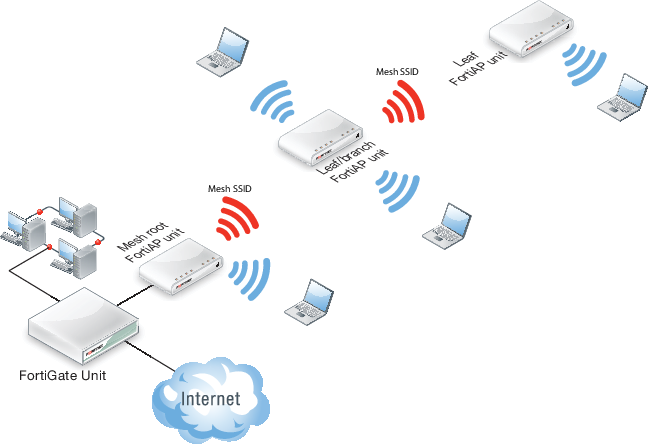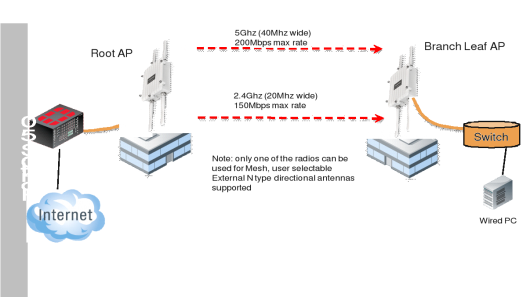Overview of Wireless Mesh
The figure below shows a wireless mesh topology.

The AP that is connected to the network by Ethernet is called the Mesh Root node. It is configured with an SSID (also called a virtual access point or VAP) dedicated to backhaul communication with the remote FortiAP units. The backhaul SSID carries CAPWAP discovery, configuration, and other communications that would usually be carried on an Ethernet connection. Regular WiFi clients cannot connect to the backhaul SSID. They connect to the regular SSIDs carried on the access points.
The root node can be a FortiAP unit or the built-in AP of a FortiWiFi unit. APs that serve only regular WiFi clients are called Leaf nodes. Leaf APs that also carry the mesh SSID for more distant Leaf nodes are called Leaf/branch nodes.
All access points in a wireless mesh configuration must have at least one of their radios configured to provide mesh backhaul communication. As with wired APs, when mesh APs start up they can be discovered by a FortiGate or FortiWiFi unit WiFi controller and authorized to join the network.
The backhaul SSID delivers the best performance when it is carried on a dedicated radio. On a two-radio FortiAP unit, for example, the 5GHz radio could carry only the backhaul SSID while the 2.4GHz radio carries one or more SSIDs that serve users. Background WiFi scanning is possible in this mode.
The backhaul SSID can also share the same radio with SSIDs that serve users. Performance is reduced because the backhaul and user traffic compete for the available bandwidth. Background WiFi scanning is not available in this mode. One advantage of this mode is that a two-radio AP can offer WiFi coverage on both bands.
The root mesh AP is the AP unit that has a wired Ethernet connection to the WiFi controller. The AP units that are wirelessly linked to the controller over the backhaul SSID are called branch or leaf APs.
Wireless mesh deployment modes
There are two common wireless mesh deployment modes:
| Wireless Mesh | Access points are wirelessly connected to a FortiGate or FortiWiFi unit WiFi controller. WiFi users connect to wireless SSIDs in the same way as on non-mesh WiFi networks. |
| Wireless bridging | Two LAN segments are connected together over a wireless link (the backhaul SSID). On the leaf AP, the Ethernet connection can be used to provide a wired network. Both WiFi and wired users on the leaf AP are connected to the LAN segment to which the root AP is connected. |
Firmware requirements
All FortiAP units that will be part of the wireless mesh network must be upgraded to FAP firmware version 5.0 build 003. FortiAP-222B units must have their BIOS upgraded to version 400012. The FortiWiFi or FortiGate unit used as the WiFi controller must be running FortiOS 5.0.
Types of wireless mesh
A WiFi mesh can provide access to widely-distributed clients. The root mesh AP which is directly connected to the WiFi controller can be either a FortiAP unit or the built-in AP of a FortiWiFi unit that is also the WiFi controller.
FortiAP units used as both mesh root AP and leaf AP
FortiWiFi unit as root mesh AP with FortiAP units as leaf APs
An alternate use of the wireless mesh functionality is as a point-to-point relay. Both wired and WiFi users on the leaf AP side are connected to the LAN segment on the root mesh side.
Point-to-point wireless mesh


